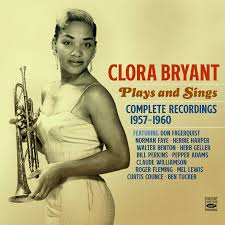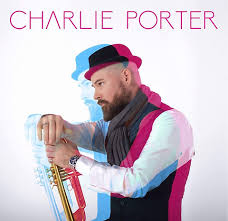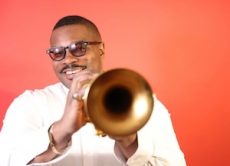
Daily Dose Of Jazz…
Clora Larea Bryant was born on May 30, 1927 in Denison, Texas to Charles and Eulila Bryant, the youngest of three children. As a young child she learned to play piano with her brother Mel, and was a member of a Baptist church choir. Her brother Fred left his trumpet when he joined the military, she picked it up and learned to play. In high school she played trumpet in the marching band.
She turned down scholarships from Oberlin Conservatory and Bennett College to attend Prairie View College in Houston, Texas starting in 1943. Bryant was a member of the Prairie View Co-eds Jazz Band which toured in Texas and performed at the Apollo Theater in New York City in 1944. Her father got a job in Los Angeles, CAlifornia and she transferred to UCLA in 1945, and where she first heard bebop on Central Avenue.
In 1946 she became a member of the International Sweethearts of Rhythm, an all-female jazz band, earned her union card and dropped out of school. Dizzy Gillespie became her mentor and provided her with work. She joined the black female jazz band the Queens of Swing as a drummer, and went on tour with the band.
In 1951 she worked in Los Angeles as a trumpeter for Josephine Baker and Billie Holiday. The same year the Queens of Swing became the first women’s jazz group to appear on television and performed as The Hollywood Sepia Tones. Clora was called onto Ada Leonard’s all-girl orchestra show, however, racist directed calls to the station the engagement. In 1954 she briefly moved to New York because she had lost inspiration from playing in bands.
Bryant recorded her first and only album, Gal With A Horn, in 1957 before returning to the life of a traveling musician. She worked with Louis Armstrong and Harry James, toured with singer Billy Williams and around the world with her brother Mel, had a TV show in Australia and became the first female jazz musician to tour in the Soviet Union after writing to Mikhail Gorbachev.
After a heart attack and quadruple bypass surgery in 1996, Bryant was forced to give up the trumpet but she continued to sing. She also began to give lectures on college campuses about the history of jazz, co-edited a book on jazz history in Los Angeles titled Central Avenue Sounds: Jazz in Los Angeles, and worked with children in Los Angeles elementary schools.
Trumpeter and vocalist Clora Bryant, who was the only female trumpeter to perform with Dizzy Gillespie and Charlie Parker and was a member of the International Sweethearts of Rhythm, died at Cedars-Sinai Medical Center in Los Angeles on August 25, 2019, after suffering a heart attack at home.
More Posts: bandleader,history,instrumental,jazz,music,trumpet,vocal

Daily Dose Of Jazz…
Charles William Porter was born May 10, 1978 in Boynton Beach, Florida. He studied trumpet at the Dreyfoos School of the Arts, The Juilliard School, Manhattan School of Music and was a Fulbright Scholar at the Paris Conservatory. His mentors include Wynton Marsalis, Mark Gould, Raymond Mase, Guy Touvron, and Laurie Frink.
Porter started in the New York jazz scene in the 1990s while studying classical music under Wynton Marsalis at the Juilliard School. He became a long-standing member of the Absolute Ensemble, and is a frequent member of the Charlie Porter Quintet, The Alan Jones Sextet and the Chuck Israels Jazz Orchestra.
As a bandleader, he has toured as both a jazz and classical musician, and released his debut self-titled album, Charlie Porter, and a sophomore project Immigration Nation. As a sideman he has recorded some two dozen albums with Philip Glass, Absolute Ensemble, Paquito D’Rivera, Tristan Murail, Billy Martin, Anthony Coleman, Russ Spiegel, Majid Khaliq, Chuck Israels, Alan Jones, and Derek Hines.
As an educator he is currently based in Portland, Oregon and presently holds the position of adjunct professor of jazz trumpet at Portland State University. Trumpeter, composer and music educator Charlie Porter, who has won several trumpet competitions and awarded a Grammy for his collaboration on the Joyce DiDonato album Songplay, continues to perform, record and teach.
More Posts: bandleader,composer,educator,history,instrumental,jazz,music,trumpet

Daily Dose Of Jazz…
Duke Jones was born Albert Jones on May 6th in White Plains, New York. The nickname was given to him by his favorite aunt due to his love of music at an early age. He began learning trumpet at the age of nine and played in elementary school through high school. He formed a band with The Lewis Brothers and Sharon Bryant that ultimately became Atlantic Starr.
Jones attended Northwestern University in Evanston, Illinois, studying music and film. He worked the New York club circuit and continued his studies with traditional island rhythms, calypso and soca at the University of Virgin Islands. He was influenced by Kenny Dorham, Woody Shaw, Lee Morgan, Benny Bailey and Miles Davis.
He would go on to tour Japan, Europe and Africa, working with The Temptations, Angela Bofill, Larry Coryell and Marion Meadows. He has collaborated and recorded with August Darnell, and drummer Norman Connors. Duke served as Vice President of Creole Records, a label started with then band mate August Darnell (Kid Creole). In 2005, he formed Café Soul All-Stars, recording their debut album Love Pages which featured George Benson, Roy Ayers and Kenny Garrett among others.
Trumpeter and flugelhornist Duke Jones continues to perform, record and collaborate with his music.
More Posts: bandleader,flugelhorn,history,instrumental,jazz,music,trumpet

JEREMY PELT QUARTET
The trumpeter studied classical trumpet as a child and focused on jazz after playing in a high school jazz ensemble. He studied at Berklee College of Music. Among those he has performed with are Ravi Coltrane, Roy Hargrove, Greg Osby, and Cassandra Wilson.
More Posts: adventure,club,genius,jazz,music,preserving,travel,trumpet

The Jazz Voyager
The Jazz Voyager is back in sunny Miami, Florida for a visit to the Koubek Center that sits on the campus of Miami Dade College. This historic landmark remains true to its pioneering heritage, the celebration of its multicultural community with workshops, art exhibitions, theater performances, literary readings, concerts and more.
This evening I will have the pleasure of hearing vocalist Leesa Richards, who has performed with Gerald Austin, Peabo Bryson, and Dionne Farris as well as toured worldwide with Whitney Houston. Also on the night’s ticket is trumpeter Jean Caze, who has worked with Herbie Hancock, Aretha Franklin, Mariah Carey, Al Jarreau, Roy Hargrove, Arturo Sandoval, and George Duke, to name a few. Both Leesa and Jean bring with them their own quartets.
The venue location is 2705 SW 3rd Street, 33135. For tickets and more information go to https://notoriousjazz.com/event/leesa-richards-quartet-jean-caze-quartet.
More Posts: adventure,club,ensemble,genius,jazz,music,preserving,travel,trumpet,vocal



